SKODA FABIA 2006 2.G / 5J Owner's Manual
Manufacturer: SKODA, Model Year: 2006, Model line: FABIA, Model: SKODA FABIA 2006 2.G / 5JPages: 258, PDF Size: 44.86 MB
Page 101 of 258
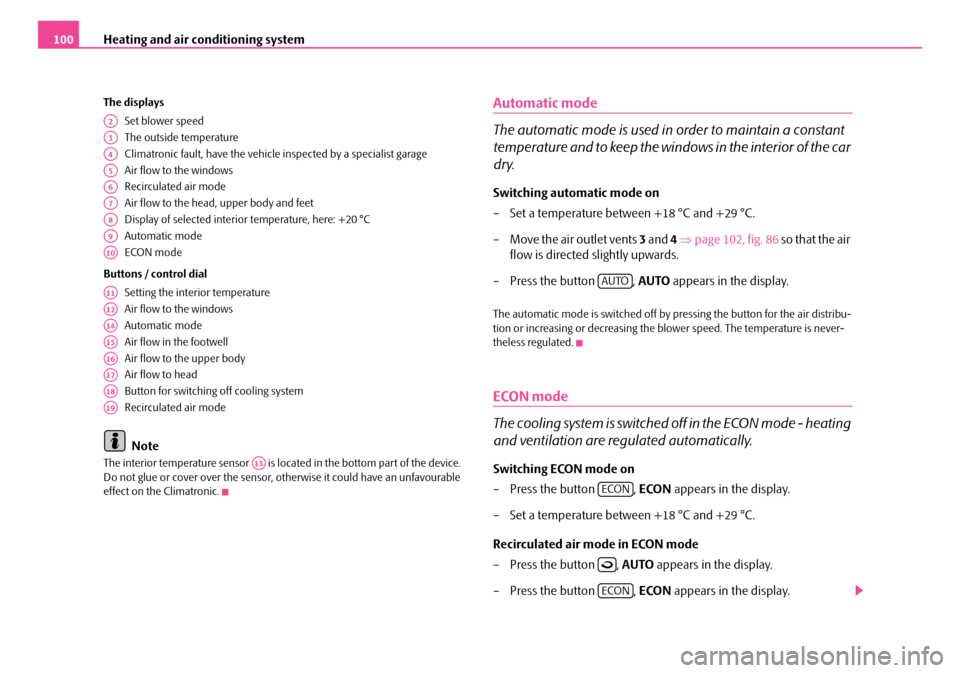
Heating and air conditioning system100
The displays
Set blower speed
The outside temperature
Climatronic fault, have the vehicl e inspected by a specialist garage
Air flow to the windows
Recirculated air mode
Air flow to the head, upper body and feet
Display of selected interior temperature, here: +20 °C
Automatic mode
ECON mode
Buttons / control dial
Setting the interior temperature
Air flow to the windows
Automatic mode
Air flow in the footwell
Air flow to the upper body
Air flow to head
Button for switching off cooling system
Recirculated air mode
Note
The interior temperature sensor is located in the bottom part of the device. Do not glue or cover over the sensor, otherwise it could have an unfavourable effect on the Climatronic.
Automatic mode
The automatic mode is used in order to maintain a constant
temperature and to keep the windows in the interior of the car
dry.
Switching automatic mode on
– Set a temperature between +18 °C and +29 °C.
– Move the air outlet vents 3 and 4 ⇒page 102, fig. 86 so that the air
flow is directed slightly upwards.
– Press the button , AUTO appears in the display.
The automatic mode is switched off by pressing the button for the air distribu- tion or increasing or decreasing the blower speed. The temperature is never- theless regulated.
ECON mode
The cooling system is switched off in the ECON mode - heating
and ventilation are regulated automatically.
Switching ECON mode on
– Press the button , ECON appears in the display.
– Set a temperature between +18 °C and +29 °C.
Recirculated air mode in ECON mode
– Press the button , AUTO appears in the display.
– Press the button , ECON appears in the display.
A2
A3
A4
A5
A6
A7
A8
A9
A10
A11
A12
A14
A15
A16
A17
A18
A19
A13
AUTO
ECON
ECON
NKO A05Fabia 20.book Page 100 Tuesday, September 26, 2006 8:38 AM
Page 102 of 258

Heating and air conditioning system101
Using the systemSafetyDriving TipsGeneral MaintenanceBreakdown assistanceTechnical Data
ECON mode operates only within the control temperature range from +18 °C up to +29 °C.
The ECON mode is switched off when pressing button or .
Please note that, in the ECON mode, th e interior temperature cannot be lower than the outside temperature. The interior is not cooled and the air is not dehu- midified.
Please refer to the information regarding recirculated air mode ⇒page 101.
Defrosting windscreen
Defrosting windscreen - switching on
– Press the button ⇒page 99, fig. 85.
Defrosting windscreen - switching off
– Once again press the button or the button .
The temperature control is controlled automatically. More air flows out of the air outlet vents 1 and2.
Recirculated air mode
In recirculated air mode air is sucked out of the interior of the
vehicle and then fed back into the interior.
Recirculated air mode prevents polluted air outside the vehicle from
getting into the vehicle, for example when driving through a tunnel or
when standing in a traffic jam.
Switching recirculated air mode on
– Press button , the symbol appears on the display.
Switching recirculated air mode off
– Once again press the button or the button , the symbol
or the logo is no long er shown on the display.
WARNING
You should not leave recirculated air mode on over a longer period of time, as “stale” air may result in fatigue in the driver and occupants, divert your attention and also cause the windows to mist up. The risk of having an accident increases. Switch recirculated air mode off as soon as the windows begin misting up.
Note
If the windscreen mists up, press the bu tton . After the windscreen has been demisted, press the button .
Setting temperature
– You can set the desired interior temperature after switching on the
ignition with the control dial .
You can set the interior temperature between +18°C and +29°C. The interior temperature is regulated automatically with in this range. If you select a temper- ature of less than +18 °C, “LO” is shown on the display. If you select a tempera- ture above +29 °C, “HI” is shown on th e display. In both limit positions the Climatronic operates at maximum cooling or heating capacity, respectively. The temperature is not cont rolled in this case.
AUTO
AUTO
AUTO
A11
NKO A05Fabia 20.book Page 101 Tuesday, September 26, 2006 8:38 AM
Page 103 of 258
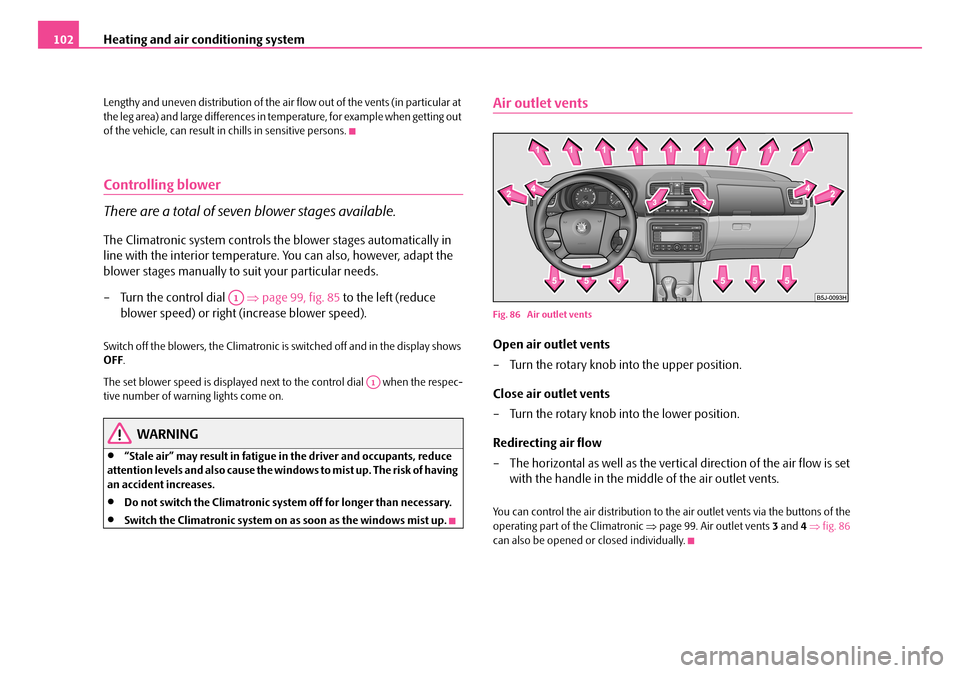
Heating and air conditioning system102
Lengthy and uneven distribution of the air flow out of the vents (in particular at the leg area) and large differences in temperature, for example when getting out of the vehicle, can result in chills in sensitive persons.
Controlling blower
There are a total of seven blower stages available.
The Climatronic system controls the blower stages automatically in
line with the interior temperature. You can also, however, adapt the
blower stages manually to suit your particular needs.
– Turn the control dial ⇒page 99, fig. 85 to the left (reduce
blower speed) or right (increase blower speed).
Switch off the blowers, the Climatronic is switched off and in the display shows OFF .
The set blower speed is displayed next to the control dial when the respec- tive number of warning lights come on.
WARNING
•“Stale air” may result in fatigue in the driver and occupants, reduce attention levels and also cause the windows to mist up. The risk of having an accident increases.
•Do not switch the Climatronic system off for longer than necessary.
•Switch the Climatronic system on as soon as the windows mist up.
Air outlet vents
Fig. 86 Air outlet vents
Open air outlet vents
– Turn the rotary knob into the upper position.
Close air outlet vents
– Turn the rotary knob into the lower position.
Redirecting air flow
– The horizontal as well as the vertic al direction of the air flow is set
with the handle in the middle of the air outlet vents.
You can control the air distribution to the air outlet vents via the buttons of the operating part of the Climatronic ⇒page 99. Air outlet vents 3 and 4 ⇒fig. 86 can also be opened or closed individually.
A1
A1
NKO A05Fabia 20.book Page 102 Tuesday, September 26, 2006 8:38 AM
Page 104 of 258

Starting-off and Driving103
Using the systemSafetyDriving TipsGeneral MaintenanceBreakdown assistanceTechnical Data
Starting-off and Driving
Setting steering wheel position*You can set the height and the forward/back position of the steering
wheel to the desired position.
– Adjust the driver seat ⇒page 69.
– Pull the lever below the steering column ⇒fig. 87 down ⇒.
– Set the steering wheel to the desired position (concerning height
and forward/back position).
– Then push the lever up against the steering column until it locks
into place.
WARNING
•You must not adjust the steering wh eel when the vehicle is moving!
•The driver must maintain a distance of at least 25 cm to the steering wheel ⇒fig. 88. Not maintaining this minimum distance will mean that the airbag system will not be able to properly protect you - hazard!
•For safety reasons the lever must always be firmly pushed up to avoid the steering wheel altering its positi on unintentionally when driving - risk of accident!
•If you adjust the steering wheel fu rther towards the head, you will reduce the protection offered by the driver airbag in the event of an acci- dent. Check that the steering wh eel is aligned to the chest.
•When driving, hold the steering wheel with both hands firmly on the outer edge in the 9 o'clock and 3 o'cl ock position. Never hold the steering wheel firmly in the 12 o'clock position or in another way (e.g. in the middle of the steering wheel or at th e inner steering wheel edge). In such cases, injuries to the arms, the hands and the head can occur when the driver airbag is deployed.
Fig. 87 Adjustable steering wheel: Lever below steering column
Fig. 88 Safe distance to steering wheel
NKO A05Fabia 20.book Page 103 Tuesday, September 26, 2006 8:38 AM
Page 105 of 258
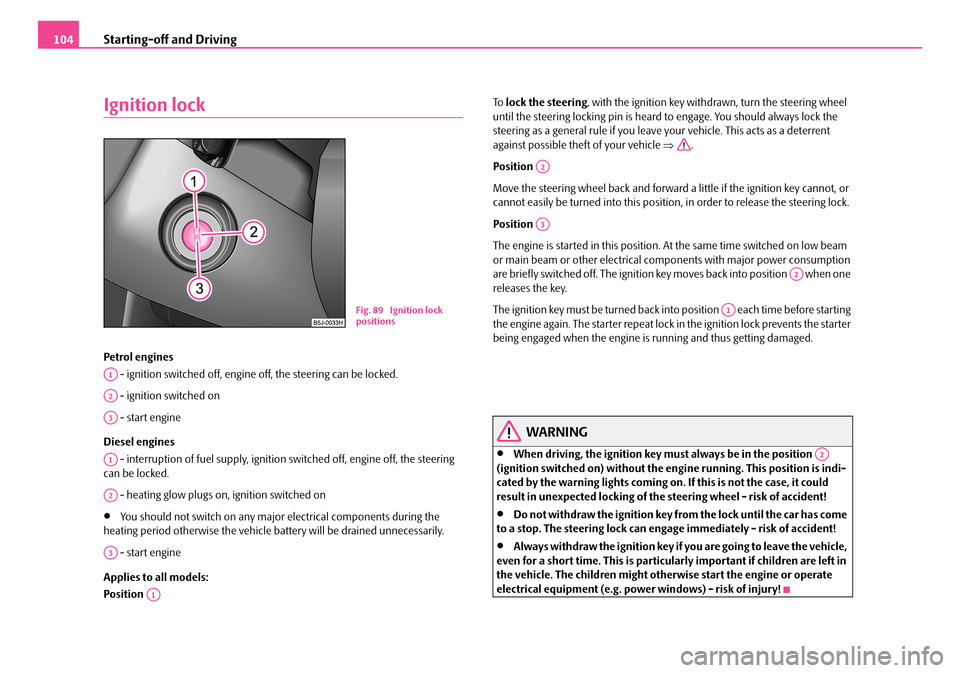
Starting-off and Driving104
Ignition lock
Petrol engines
- ignition switched off, engine off, the steering can be locked.
- ignition switched on
- start engine
Diesel engines
- interruption of fuel supply, ignition switched off, engine off, the steering can be locked.
- heating glow plugs on, ignition switched on
•You should not switch on any major electrical components during the heating period otherwise the vehicle ba ttery will be drained unnecessarily.
- start engine
Applies to all models:
Position
To lock the steering, with the ignition key withdrawn, turn the steering wheel until the steering locking pin is heard to engage. You should always lock the steering as a general rule if you leave your vehicle. This acts as a deterrent against possible thef t of your vehicle ⇒.
Position
Move the steering wheel back and forward a little if the ignition key cannot, or cannot easily be turned into this position, in order to release the steering lock.
Position
The engine is started in this position. At the same time switched on low beam or main beam or other electrical co mponents with major power consumption are briefly switched off. The ignition key moves back into position when one releases the key.
The ignition key must be turned back into position each time before starting the engine again. The starter repeat lock in the ignition lock prevents the starter being engaged when the engine is running and thus getting damaged.
WARNING
•When driving, the ignition key must always be in the position (ignition switched on) without the engine running. This position is indi- cated by the warning lights coming on. If this is not the case, it could result in unexpected locking of the steering wheel - risk of accident!
•Do not withdraw the ignition key from the lock until the car has come to a stop. The steering lock can enga ge immediately - risk of accident!
•Always withdraw the ignition key if you are going to leave the vehicle, even for a short time. This is particularly important if children are left in the vehicle. The children might othe rwise start the engine or operate electrical equipment (e.g. power windows) - risk of injury!
Fig. 89 Ignition lock positions
A1
A2
A3
A1
A2
A3
A1
A2
A3
A2
A1
A2
NKO A05Fabia 20.book Page 104 Tuesday, September 26, 2006 8:38 AM
Page 106 of 258
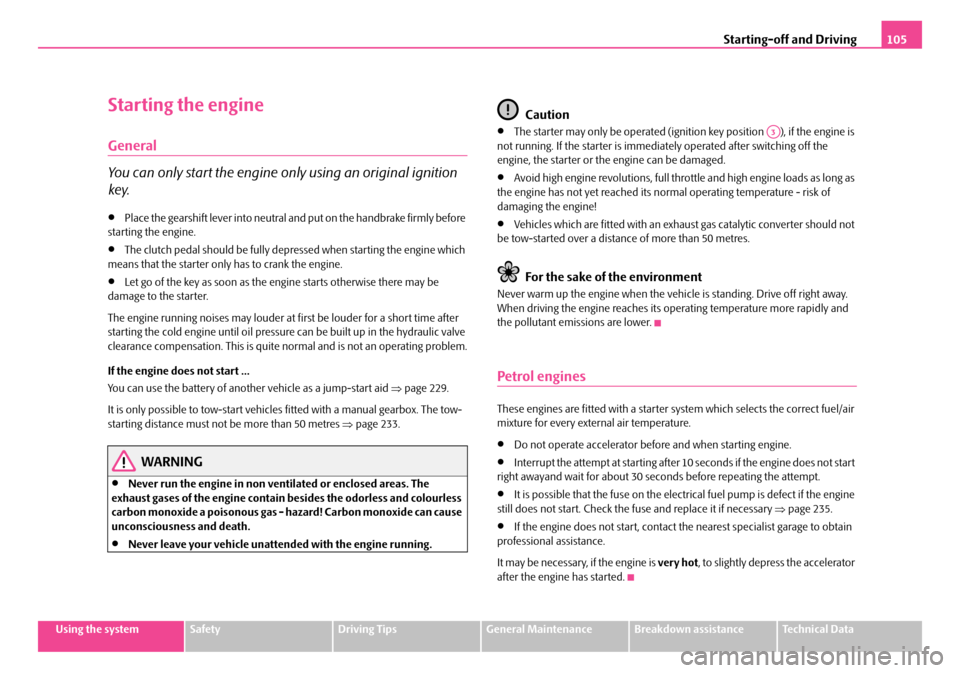
Starting-off and Driving105
Using the systemSafetyDriving TipsGeneral MaintenanceBreakdown assistanceTechnical Data
Starting the engine
General
You can only start the engine only using an original ignition
key.
•Place the gearshift lever into neutral an d put on the handbrake firmly before starting the engine.
•The clutch pedal should be fully depr essed when starting the engine which means that the starter only has to crank the engine.
•Let go of the key as soon as the engine starts otherwise there may be damage to the starter.
The engine running noises ma y louder at first be louder for a short time after starting the cold engine until oil pressure can be built up in the hydraulic valve clearance compensation. This is quite normal and is not an operating problem.
If the engine does not start ...
You can use the battery of anothe r vehicle as a jump-start aid ⇒page 229.
It is only possible to tow-start vehicl es fitted with a manual gearbox. The tow- starting distance must not be more than 50 metres ⇒page 233.
WARNING
•Never run the engine in non ventilated or enclosed areas. The exhaust gases of the engine contain besides the odorless and colourless carbon monoxide a poisonous gas - hazard! Carbon monoxide can cause unconsciousness and death.
•Never leave your vehicle unattended with the engine running.
Caution
•The starter may only be operated (ignition key position ), if the engine is not running. If the starter is immediately operated after switching off the engine, the starter or the engine can be damaged.
•Avoid high engine revolutions, full thrott le and high engine loads as long as the engine has not yet reached its norm al operating temperature - risk of damaging the engine!
•Vehicles which are fitted with an exha ust gas catalytic converter should not be tow-started over a distance of more than 50 metres.
For the sake of the environment
Never warm up the engine when the vehi cle is standing. Drive off right away. When driving the engine reaches its operating temperature more rapidly and the pollutant emissions are lower.
Petrol engines
These engines are fitted with a starter system which selects the correct fuel/air mixture for every external air temperature.
•Do not operate accelerator before and when starting engine.
•Interrupt the attempt at starting after 10 seconds if the engine does not start right awayand wait for about 30 seconds before repeating the attempt.
•It is possible that the fuse on the electrical fuel pump is defect if the engine still does not start. Check the fuse and replace it if necessary ⇒page 235.
•If the engine does not start, contact the nearest specialist garage to obtain professional assistance.
It may be necessary, if the engine is very hot, to slightly depress the accelerator after the engine has started.
A3
NKO A05Fabia 20.book Page 105 Tuesday, September 26, 2006 8:38 AM
Page 107 of 258

Starting-off and Driving106
Diesel engines
Glow plug system
Diesel engines are equipped with a glow plug system, the preglow period being controlled automatically in line with the coolant temperature and outside temperature.
The preglow indicator light comes on after the ignition has been switched on.
You should not switch on any major electrical components during the heating period otherwise the vehicle battery will be drained unneces- sarily.
•You should start the engine immediately after the glow plug warning light has gone out.
•The glow plug warning light will come on for about one second if the engine is at a normal operating temperature or if the outside temperature is above +5°C. This means that you can start the engine right away.
•Interrupt the attempt at starting after 10 seconds if the engine does not start right awayand wait for about 30 seco nds before repeating the attempt.
•It is possible that the fuse on the diesel preglow system is defect if the engine still does not start. Check th e fuse and replace it if necessary ⇒ page 235.
•Contact the nearest specialist garage to obtain professional assistance.
Starting the engine after fuel tank has run dry
It may take longer than normal to start th e engine after refuelling if the fuel tank has run completely dry - up to one minute. This is because the fuel system must first of all be filled while the attempting to start the engine.
Switching off the engine
– The engine can be sw itched off by turning the ignition key from
position ⇒page 104, fig. 89 into position .
WARNING
•Never switch off the engine before the vehicle is stationary - risk of accident!
•The brake booster only operates when the engine is running. Greater physical effort for braking is required when engine is switched off. Because if you do not stop as normal, this can cause an accident and severe injuries.
Caution
you should not switch the engine off righ t away at the end of your journey after the engine has been operated for a length y period at high loads but should be allowed it to run at idling speed for about 2 minutes. This prevents any accumu- lation of heat when the engine is switched off.
Note
•The radiator fan may continue running for a further 10 minutes or so after the engine and the ignition have been switched off. The coolant fan may, however, also switch on again after some time if the coolant temperature rises because of an accumulation of heat in th e engine or if the engine is warm and the engine compartment is additionally heated by strong sunlight.
•This is why particular care is requir ed when carrying out any work in the engine compartment ⇒page 198, “Working in the engine compartment”.
A1
NKO A05Fabia 20.book Page 106 Tuesday, September 26, 2006 8:38 AM
Page 108 of 258
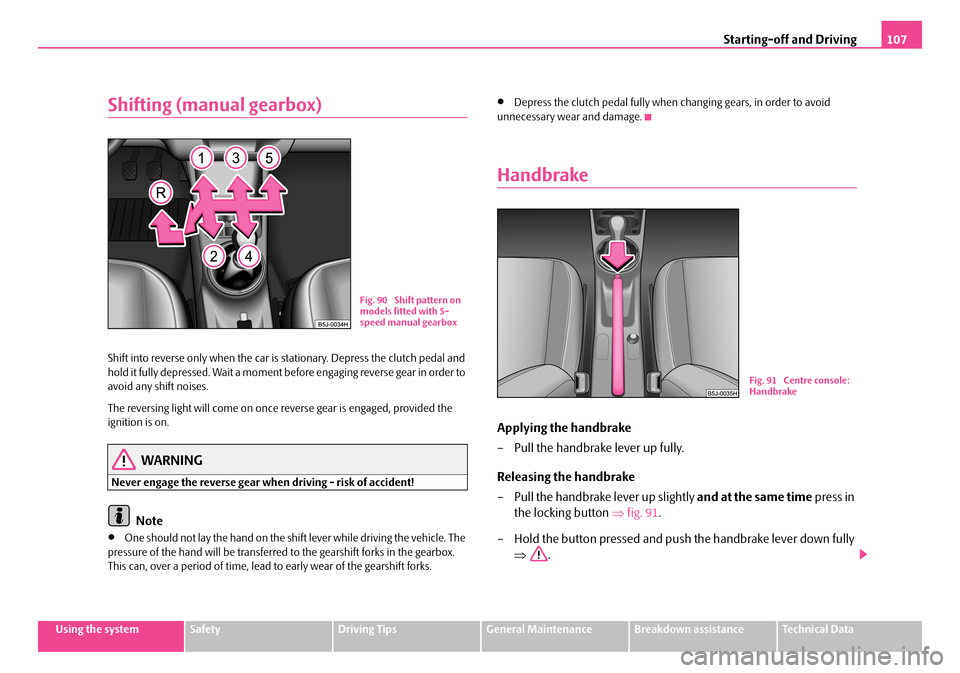
Starting-off and Driving107
Using the systemSafetyDriving TipsGeneral MaintenanceBreakdown assistanceTechnical Data
Shifting (manual gearbox)
Shift into reverse only when the car is stationary. Depress the clutch pedal and hold it fully depressed. Wait a moment before engaging reverse gear in order to avoid any shift noises.
The reversing light will come on once reverse gear is engaged, provided the ignition is on.
WARNING
Never engage the reverse gear when driving - risk of accident!
Note
•One should not lay the hand on the shift lever while driving the vehicle. The pressure of the hand will be transferre d to the gearshift forks in the gearbox. This can, over a period of time, lead to early wear of the gearshift forks.
•Depress the clutch pedal fully when changing gears, in order to avoid unnecessary wear and damage.
Handbrake
Applying the handbrake
– Pull the handbrake lever up fully.
Releasing the handbrake
– Pull the handbrake lever up slightly and at the same time press in
the locking button ⇒fig. 91.
– Hold the button pressed and push the handbrake lever down fully
⇒ .
Fig. 90 Shift pattern on models fitted with 5-speed manual gearbox
Fig. 91 Centre console: Handbrake
NKO A05Fabia 20.book Page 107 Tuesday, September 26, 2006 8:38 AM
Page 109 of 258
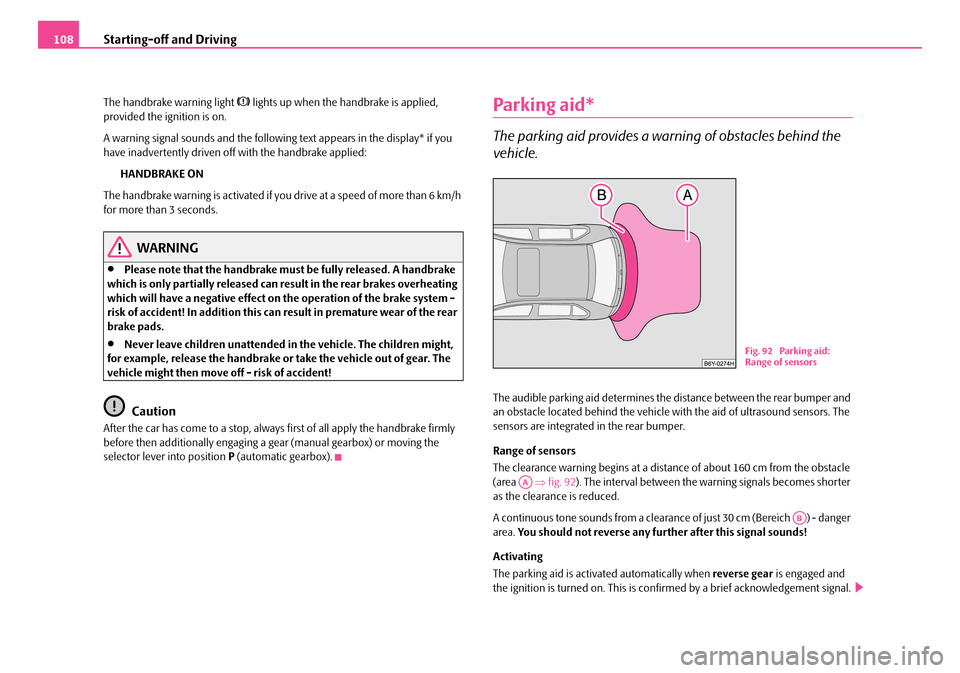
Starting-off and Driving108
The handbrake warning light lights up when the handbrake is applied, provided the ignition is on.
A warning signal sounds and the following text appears in the display* if you have inadvertently driven off with the handbrake applied:
HANDBRAKE ON
The handbrake warning is activated if you drive at a speed of more than 6 km/h for more than 3 seconds.
WARNING
•Please note that the handbrake must be fully released. A handbrake which is only partially released can re sult in the rear brakes overheating which will have a negative effect on the operation of the brake system - risk of accident! In addition this can result in premature wear of the rear brake pads.
•Never leave children unattended in the vehicle. The children might, for example, release the handbrake or take the vehicle out of gear. The vehicle might then move off - risk of accident!
Caution
After the car has come to a stop, always first of all apply the handbrake firmly before then additionally engaging a gear (manual gearbox) or moving the selector lever into position P (automatic gearbox).
Parking aid*
The parking aid provides a warning of obstacles behind the
vehicle.
The audible parking aid determines the distance between the rear bumper and an obstacle located behind the vehicle wi th the aid of ultrasound sensors. The sensors are integrated in the rear bumper.
Range of sensors
The clearance warning begins at a distan ce of about 160 cm from the obstacle (area ⇒fig. 92). The interval between the warning signals becomes shorter as the clearance is reduced.
A continuous tone sounds fr om a clearance of just 30 cm (Bereich ) - danger area. You should not reverse any further after this signal sounds!
Activating
The parking aid is activated automatically when reverse gear is engaged and the ignition is turned on. This is conf irmed by a brief acknowledgement signal.
Fig. 92 Parking aid: Range of sensors
AA
AB
NKO A05Fabia 20.book Page 108 Tuesday, September 26, 2006 8:38 AM
Page 110 of 258
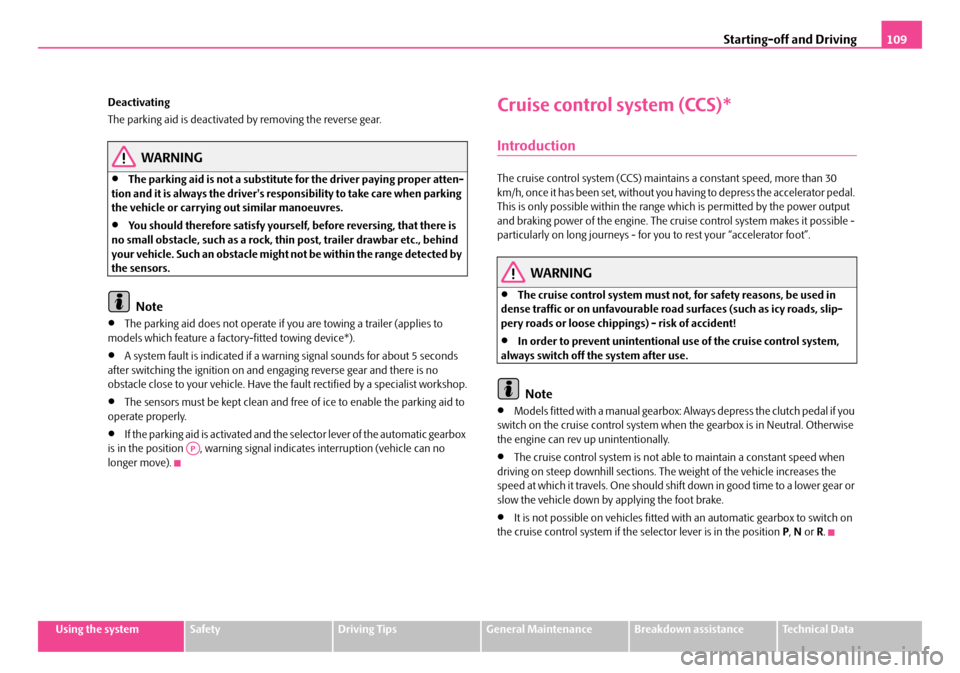
Starting-off and Driving109
Using the systemSafetyDriving TipsGeneral MaintenanceBreakdown assistanceTechnical Data
Deactivating
The parking aid is deactivated by removing the reverse gear.
WARNING
•The parking aid is not a substitute for the driver paying proper atten- tion and it is always the driver's responsibility to take care when parking the vehicle or carrying out similar manoeuvres.
•You should therefore satisfy yourself, before reversing, that there is no small obstacle, such as a rock, th in post, trailer drawbar etc., behind your vehicle. Such an obstacle might not be within the range detected by the sensors.
Note
•The parking aid does not operate if you are towing a trailer (applies to models which feature a fact ory-fitted towing device*).
•A system fault is indicated if a warning signal sounds for about 5 seconds after switching the ignition on and engaging reverse gear and there is no obstacle close to your vehicle. Have the fault rectified by a specialist workshop.
•The sensors must be kept clean and free of ice to enable the parking aid to operate properly.
•If the parking aid is activated and the selector lever of the automatic gearbox is in the position , warning signal indicates interruption (vehicle can no longer move).
Cruise control system (CCS)*
Introduction
The cruise control system (CCS) maintains a constant speed, more than 30 km/h, once it has been set, without you having to depress the accelerator pedal. This is only possible within the range which is permitted by the power output and braking power of the engine. The cruise control system makes it possible - particularly on long journeys - for you to rest your “accelerator foot”.
WARNING
•The cruise control system must not, for safety reasons, be used in dense traffic or on unfavourable road surfaces (such as icy roads, slip- pery roads or loose chippings) - risk of accident!
•In order to prevent unintentional use of the cruise control system, always switch off the system after use.
Note
•Models fitted with a manual gearbox: Always depress the clutch pedal if you switch on the cruise control system when the gearbox is in Neutral. Otherwise the engine can rev up unintentionally.
•The cruise control system is not able to maintain a constant speed when driving on steep downhill sections. The weight of the vehicle increases the speed at which it travels. One should shift down in good time to a lower gear or slow the vehicle down by applying the foot brake.
•It is not possible on vehi cles fitted with an automatic gearbox to switch on the cruise control system if the selector lever is in the position P, N or R.
AP
NKO A05Fabia 20.book Page 109 Tuesday, September 26, 2006 8:38 AM